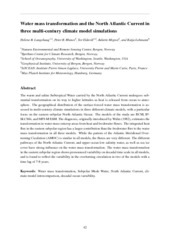Water mass transformation and the North Atlantic Current in three multi-century climate model simulations
Journal article
Submitted version
Permanent lenke
https://hdl.handle.net/1956/5278Utgivelsesdato
2012-11Metadata
Vis full innførselSamlinger
- Geophysical Institute [1198]
Originalversjon
https://doi.org/10.1029/2012jc008021Sammendrag
The warm and saline Subtropical Water carried by the North Atlantic Current undergoes substantial transformation on its way to higher latitudes as heat is released from ocean to atmosphere. The geographical distribution of the surface-forced water mass transformation is assessed in multi-century climate simulations in three different climate models, with a particular focus on the eastern subpolar North Atlantic Ocean. The models of the study are BCM, IPSLCM4, and MPI-M ESM. The diagnosis, originally introduced byWalin (1982), estimates the transformation in water mass outcrop areas from heat and freshwater fluxes. The integrated heat flux in the eastern subpolar region has a larger contribution than the freshwater flux to the water mass transformation in all three models. While the pattern of the Atlantic Meridional Overturning Ciculation (AMOC) is similar in all models, the fluxes are very different. The different pathways of the North Atlantic Current, and upper ocean low salinity water, as well as sea ice cover have strong influence on the water mass transformation. The water mass transformation in the eastern subpolar region shows pronounced variability on decadal time scale in all models, and is found to reflect the variability in the overturning circulation in two of the models with a time lag of 7-8 years.
